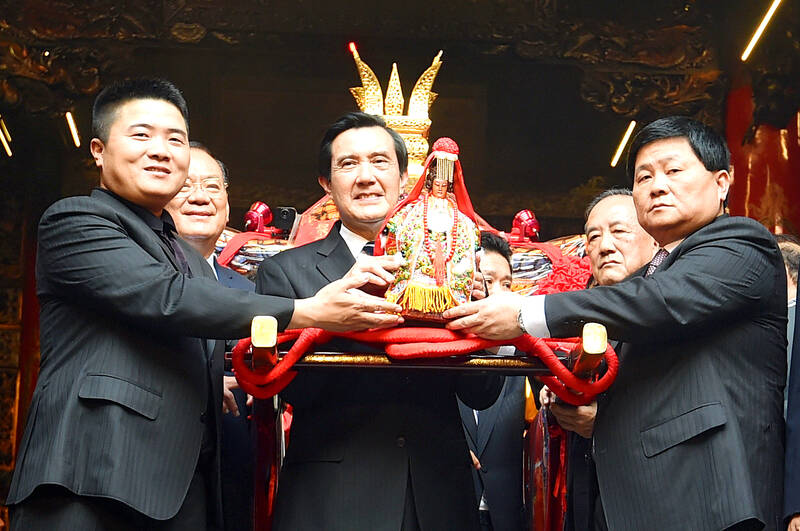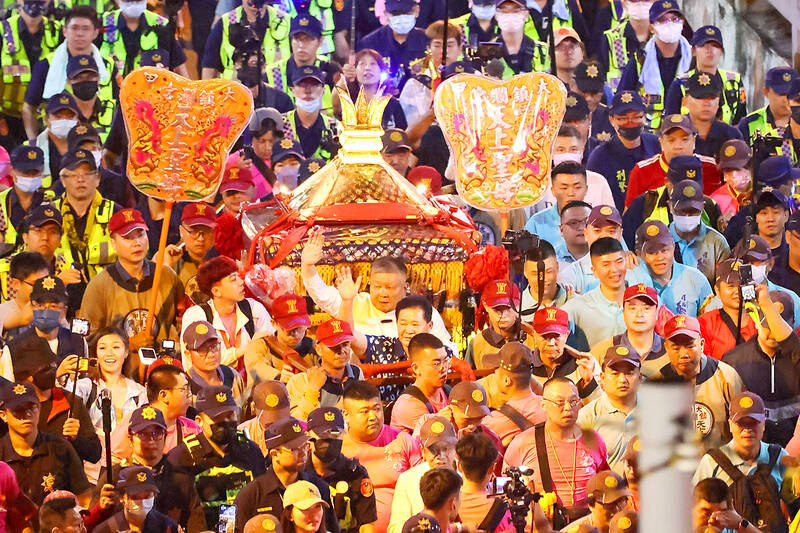For over half a century the Chinese Nationalist Party’s (KMT) patronage faction system remained fairly stable, but then quickly evolved with democratization. To understand these fascinating developments, we have to first understand how the system evolved in the first place.
The KMT’s Republic of China (ROC) government faced several dilemmas after it fled to Taiwan.
One was maintaining the fiction that they represented “Free China” to the world and in the UN. Through masterful use of the “China lobby” in Washington DC, the US Congress was spending billions propping up Generalissimo Chiang Kai-shek’s (蔣介石) regime. Remarkably, it even still had some idealistic followers.

Photo: Liao Yao-tung, Taipei Times
Few in the KMT could speak the local languages, and few locals could speak Mandarin. They could — and did — shoot or jail anyone even remotely suspected of being against the regime or of being a Communist sympathizer, but they needed local supporters they could rely on.
At the national level, they justified imposing martial law, claiming a still ongoing Chinese Civil War, and to mobilize the nation against Communism and “retake the mainland.”
Seats in the Legislative Yuan covered the entirety of China, even though the KMT had no control over any of it. Those elected to the legislature in 1947 would permanently represent those seats — all the way up to the 1990s, by which point many of the legislators were in wheelchairs.

Photo: Chen Kuan-pei, Taipei Times
To keep control of political parties, they banned the formation of new ones, leaving only the KMT and a handful of smaller puppet parties founded in China.
AN EFFECTIVE METHOD OF CONTROL
With these factors in mind, they started holding local elections. They were legitimate enough that from time to time independent candidates would win.
To maintain control at local level, the KMT turned to Taiwanese elites.
These elites joined the KMT but split into factions, turning elections into battles between KMT candidates aligned with different factions made up of Taiwanese.
These factions — whom the KMT did not trust — were banned from spreading or making alliances outside of their local city or county.
To fund their campaigns, build client networks and line their own pockets, these factions took control of agricultural and irrigation associations, local credit cooperatives and similar local functions.
These elites took control of temples, which, to this day, are known for money laundering due to lax reporting requirements. This is still true, and the chairman of Jenn Lann Temple, which runs the world’s largest Matsu pilgrimage, is Yen Ching-piao (顏清標), the head of Taichung’s Black Faction.
Temples also had what I have dubbed “temple toughs,” young men trained to fight, some of whom trace their lineage to Qing Dynasty-era militias.
Having control of the levers of government and the police — which often had ties to organized crime — few could stand in their way.
They also lined their pockets with bribes and during government land auctions few would have the courage to bid against them, ensuring them cheap access to property.
All this made it very hard for independent candidates to break through.
The corruption inherent in the system put them at the mercy of the KMT.
The most common names for these factions were usually the surname of the founder (“Hsieh faction”) or the colors red, white and black. The three colors came from the color of the leaflets used in their very first election, and the names stuck.
By the 1980s and 1990s powerful factional politicians and their family clans had amassed considerable property and wealth.
WHAT I WITNESSED FIRST HAND
This was my introduction to Taiwan politics.
I taught at four cram schools across Changhua County and two were owned by powerful factional county councilors, including the one who owned the cram school in Hemei Township (和美), where I lived.
There is not much online about him, but my ex-girlfriend at the time remembers his full name as Chen Chung-tsai (陳忠財).
I called him “Mr. Chen” and he found it very amusing to take my 19 and 20-year-old self out drinking. I suspect he was showing me off at a time when Westerners were rare.
He drank all day and all night with everyone from constituents to local business owners to government officials, and there was much debauchery and womanizing.
As a good politician, Chen would match the drink of choice to the status of who was drinking with — illegal moonshine rice wine with farmers to expensive French cognac with factory owners and government officials.
I remember him pounding on my door at 10:30am — unnerving behavior from a boss — to get ready to go drink in downtown Changhua City at a KTV. I eventually convinced him I was not a daytime drinker, but I had not yet learned how to put my foot down with the boss.
The first time I encountered vote buying was at a cram school, where I saw a mountain of neatly stacked NT$500 banknotes. Curious about what the money was for, I joked: “is that for me?”
They said matter of factly that it was for buying votes. The money was on the counter of the cram school and anyone passing by could easily see it through the wall-sized window facing the street.
I was told later that Chen died in his late 40s from throat cancer, unsurprising considering all his smoking and betel nut chewing.
CHANGE ON THE HORIZON
This system thrived from the late 1940s well into the 1990s, but democracy inevitably brought change and hostility from some in the higher echelons of the KMT, dominated by those from families who had fled the Chinese Civil War. They viewed the brazen corruption of the factions a stain on the party’s image at a time when it was facing significant electoral competition.
Possibly their fiercest foe was then justice minister and future president Ma Ying-jeou (馬英九).
In an upcoming column we will examine that story and much more that changed the factions starting in the later 1990s onwards.
Donovan’s Deep Dives is a regular column by Courtney Donovan Smith (石東文) who writes in-depth analysis on everything about Taiwan’s political scene and geopolitics. Donovan is also the central Taiwan correspondent at ICRT FM100 Radio News, co-publisher of Compass Magazine, co-founder Taiwan Report (report.tw) and former chair of the Taichung American Chamber of Commerce. Follow him on X: @donovan_smith.

That US assistance was a model for Taiwan’s spectacular development success was early recognized by policymakers and analysts. In a report to the US Congress for the fiscal year 1962, former President John F. Kennedy noted Taiwan’s “rapid economic growth,” was “producing a substantial net gain in living.” Kennedy had a stake in Taiwan’s achievements and the US’ official development assistance (ODA) in general: In September 1961, his entreaty to make the 1960s a “decade of development,” and an accompanying proposal for dedicated legislation to this end, had been formalized by congressional passage of the Foreign Assistance Act. Two

Despite the intense sunshine, we were hardly breaking a sweat as we cruised along the flat, dedicated bike lane, well protected from the heat by a canopy of trees. The electric assist on the bikes likely made a difference, too. Far removed from the bustle and noise of the Taichung traffic, we admired the serene rural scenery, making our way over rivers, alongside rice paddies and through pear orchards. Our route for the day covered two bike paths that connect in Fengyuan District (豐原) and are best done together. The Hou-Feng Bike Path (后豐鐵馬道) runs southward from Houli District (后里) while the

March 31 to April 6 On May 13, 1950, National Taiwan University Hospital otolaryngologist Su You-peng (蘇友鵬) was summoned to the director’s office. He thought someone had complained about him practicing the violin at night, but when he entered the room, he knew something was terribly wrong. He saw several burly men who appeared to be government secret agents, and three other resident doctors: internist Hsu Chiang (許強), dermatologist Hu Pao-chen (胡寶珍) and ophthalmologist Hu Hsin-lin (胡鑫麟). They were handcuffed, herded onto two jeeps and taken to the Secrecy Bureau (保密局) for questioning. Su was still in his doctor’s robes at

Mirror mirror on the wall, what’s the fairest Disney live-action remake of them all? Wait, mirror. Hold on a second. Maybe choosing from the likes of Alice in Wonderland (2010), Mulan (2020) and The Lion King (2019) isn’t such a good idea. Mirror, on second thought, what’s on Netflix? Even the most devoted fans would have to acknowledge that these have not been the most illustrious illustrations of Disney magic. At their best (Pete’s Dragon? Cinderella?) they breathe life into old classics that could use a little updating. At their worst, well, blue Will Smith. Given the rapacious rate of remakes in modern